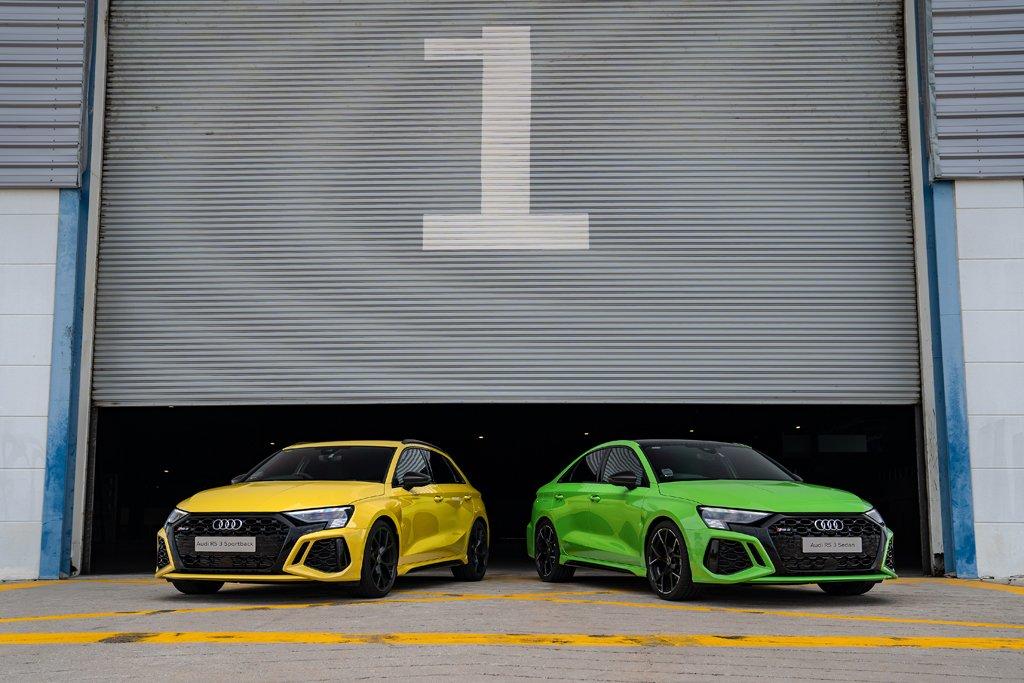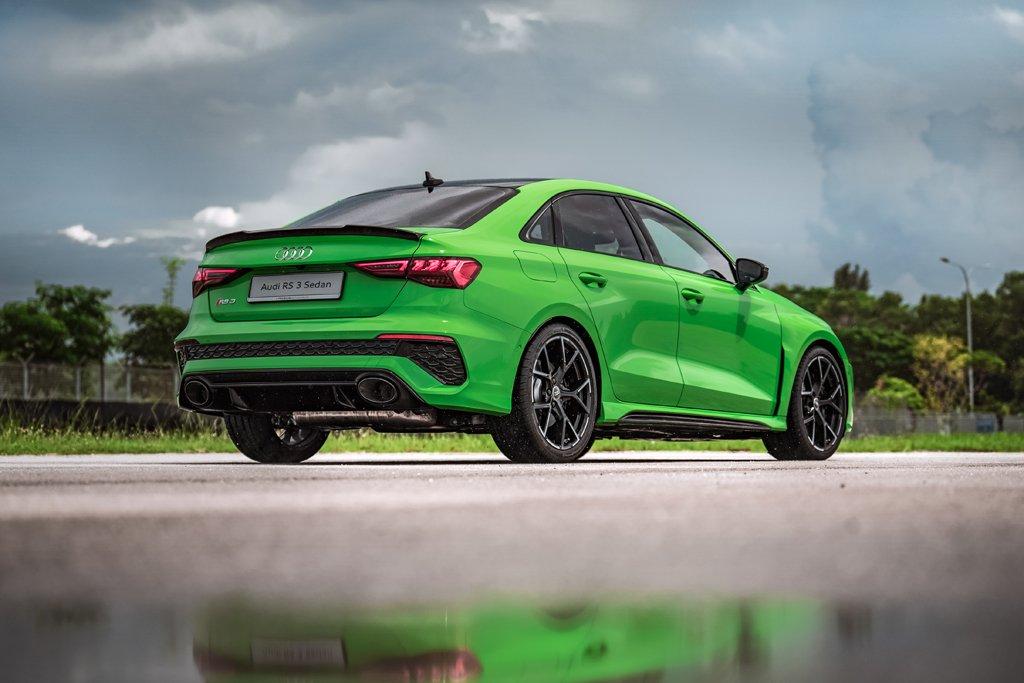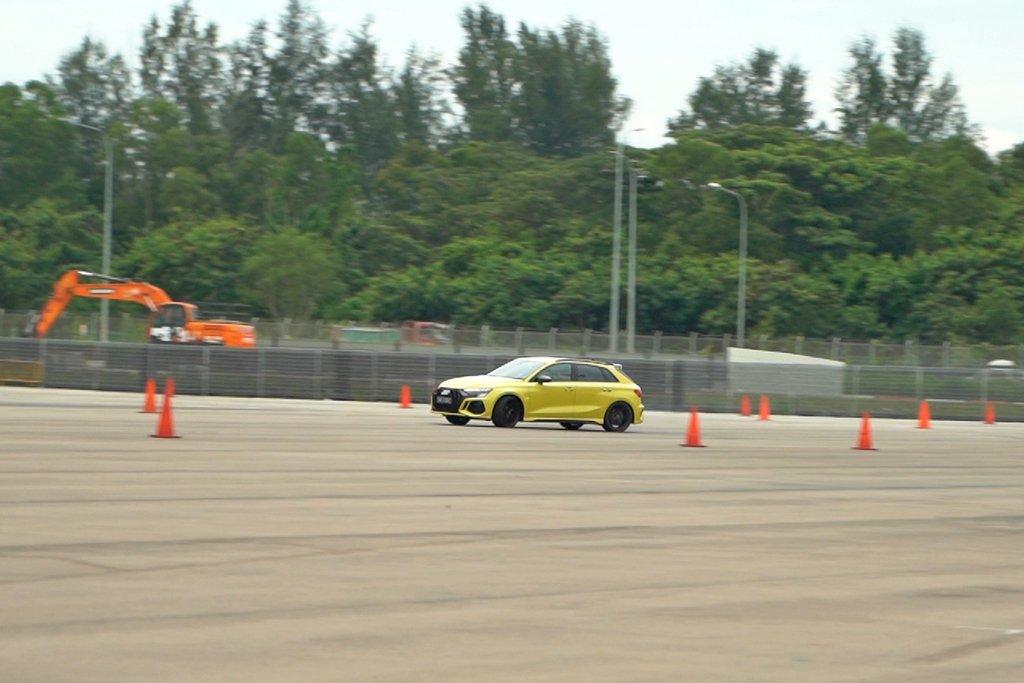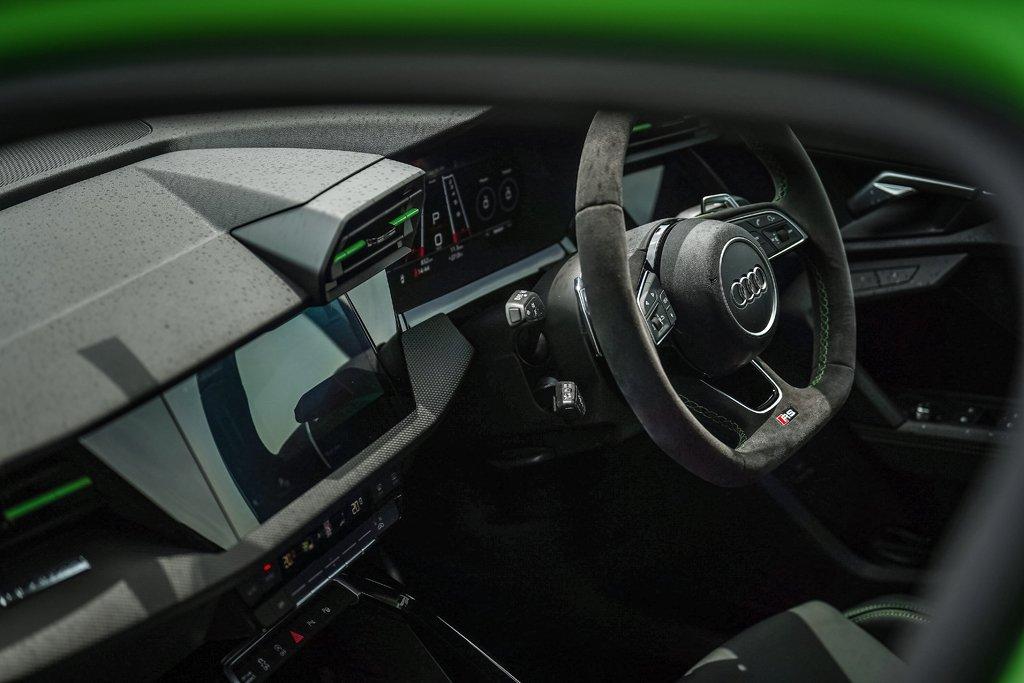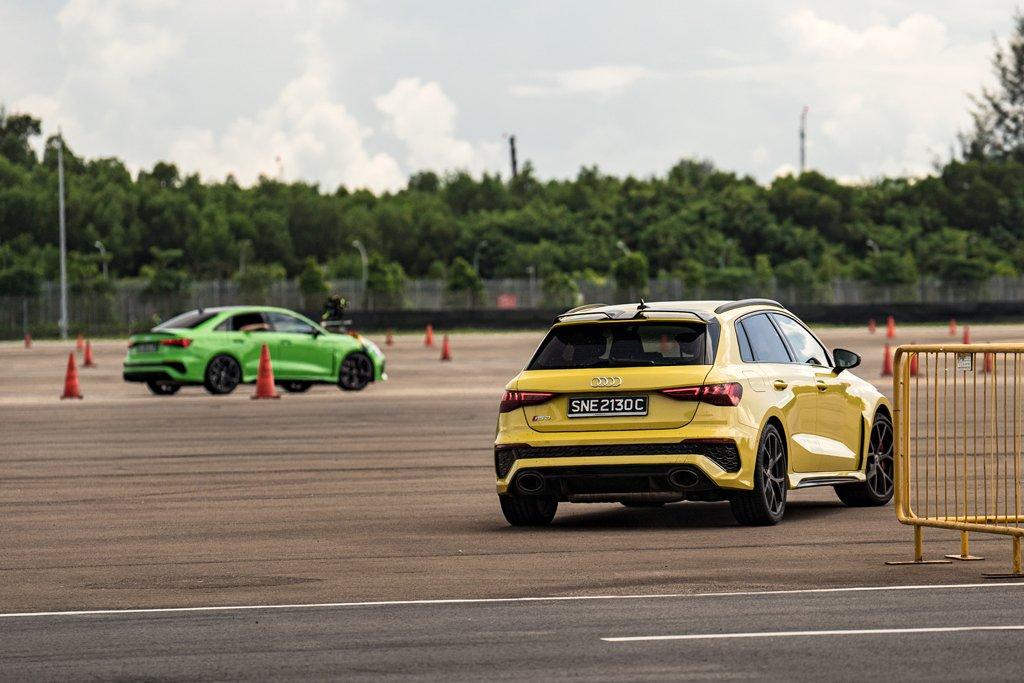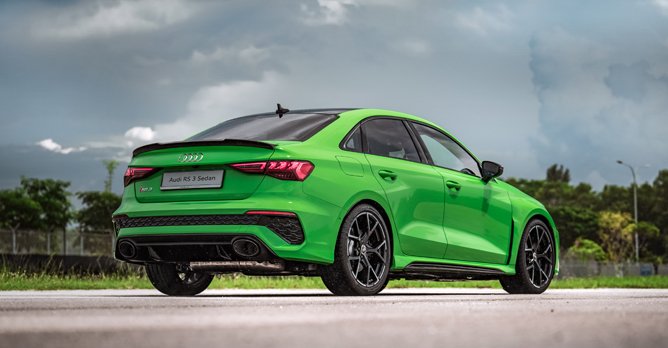The new Audi RS3 was introduced to the media through an exhilarating driving experience event
14 Apr 2022|1,121 views
Entering a turn marked out by cones with front wheels pointing the wrong way and rear tyres squealing the entire time - you might mistake this as drifting event, but it really was just how Audi decided to introduce the media to the new RS3 Sedan and Sportback and their all-new RS Torque Rear mode at Changi Exhibition Centre.
Yes, your eyes aren't playing tricks, the new RS3 with its Quattro all-wheel drive (AWD) system is capable of kicking its tail end loose, but we'll touch more on that a little bit later.
First, let's talk about the engine within. Originally introduced in the TT RS and producing 335bhp, Audi's legendary turbocharged five-cylinder 2.5-litre quickly became famous for its V10-esque creamy soundtrack as well as its humongous tuning potential - aftermarket companies were managing four digit horsepower figures with upgrades.
With the latest RS3, Audi has managed to wring 395bhp and 500Nm of torque out of the powerplant, all while achieving a steeper power curve with an expanded power range. This translates to a 3.8 seconds century sprint, a figure that is 0.3 seconds faster than the previous RS3, and it would accelerate to an electronically limited top speed of 250km/h (290km/h with the RS dynamics package plus).
All the eye-watering power is effectively put to the ground by Audi's Quattro AWD system with an all new RS torque splitter that is able to actively and variably distribute drive torque between the rear wheels for maximum agility.
An electronically controlled multiple disc clutch is used on each of the rear drive shafts, allowing the individual rear wheel torque to be controlled independently - this means that the torque splitter is able to increase torque delivered to the outer rear wheel with the higher wheel load to significantly reduce the tendency to understeer.
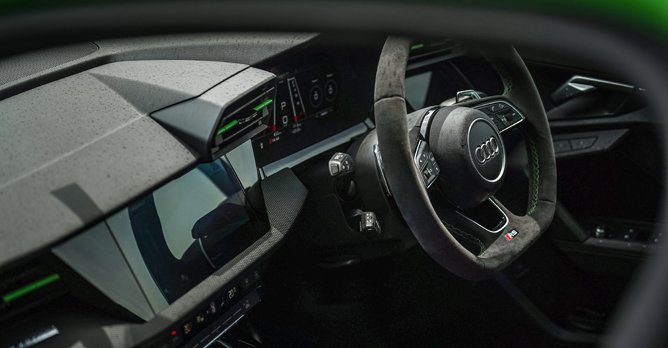
 Hop in and you'll quickly realise the RS3 not only looks fast on the exterior - it has a similarly sporty interior to match The RS torque splitter is also how the new RS3 is able to perform ludicrous drifts akin to a rear-wheel drive machine - set it to RS Torque Rear and the car puts down up to 100% of the drive torque to the rear outer wheel, breaking its hold on the ground free and allowing the car to slide. Having been given the opportunity to try this feature out in a safe environment, we can assure you that the RS3 drifts really well.
Hop in and you'll quickly realise the RS3 not only looks fast on the exterior - it has a similarly sporty interior to match The RS torque splitter is also how the new RS3 is able to perform ludicrous drifts akin to a rear-wheel drive machine - set it to RS Torque Rear and the car puts down up to 100% of the drive torque to the rear outer wheel, breaking its hold on the ground free and allowing the car to slide. Having been given the opportunity to try this feature out in a safe environment, we can assure you that the RS3 drifts really well.
While the drivetrain is likely the most significant change on the new RS3, improvements can be found throughout the car. The RS3's stiffer body sits lower than the S3 and A3, while the suspension also gets enhanced with RS 3-specific components to improve steering response, in addition to greater lateral control.

 Massive 375mm disc rotors and large six-piston brakes on the front are standard equipment on the RS3 With the increased power and performance, Audi has also included a newly developed and larger six-piston brake with internally ventilated and drilled discs measuring 375mm at the front and 310mm at the rear - 5mm larger than its predecessor.
Massive 375mm disc rotors and large six-piston brakes on the front are standard equipment on the RS3 With the increased power and performance, Audi has also included a newly developed and larger six-piston brake with internally ventilated and drilled discs measuring 375mm at the front and 310mm at the rear - 5mm larger than its predecessor.
Although we have been going on and on about the drive and performance of the RS3, there's more to it than just that.
Returning once again in both Sedan and Sportback body types, the sporty exterior of the RS3 has been updated and grown in size. The Sedan is 63mm longer, 49mm wider and 13mm higher while the Sportback is 50mm wider and longer and 25mm higher.
The front of the RS3 features a wide RS bumper with extra-large intakes, leading to a pair of fenders that has been flared accordingly to accommodate the RS3's 33mm wider front track, creating the unmistakable look of a performance Audi.
Continue to the rear of the RS3 and you'll see the rear bumper with an integrated diffuser sporting a large oval tailpipe at each far end. Meanwhile, a distinctive roof edge spoiler and an RS-specific lip on the boot complete the RS treatment on the Sportback and Sedan respectively.
Want to see more tail happy action in the Audi RS3? We have just the thing you need!
Yes, your eyes aren't playing tricks, the new RS3 with its Quattro all-wheel drive (AWD) system is capable of kicking its tail end loose, but we'll touch more on that a little bit later.
First, let's talk about the engine within. Originally introduced in the TT RS and producing 335bhp, Audi's legendary turbocharged five-cylinder 2.5-litre quickly became famous for its V10-esque creamy soundtrack as well as its humongous tuning potential - aftermarket companies were managing four digit horsepower figures with upgrades.
With the latest RS3, Audi has managed to wring 395bhp and 500Nm of torque out of the powerplant, all while achieving a steeper power curve with an expanded power range. This translates to a 3.8 seconds century sprint, a figure that is 0.3 seconds faster than the previous RS3, and it would accelerate to an electronically limited top speed of 250km/h (290km/h with the RS dynamics package plus).
All the eye-watering power is effectively put to the ground by Audi's Quattro AWD system with an all new RS torque splitter that is able to actively and variably distribute drive torque between the rear wheels for maximum agility.
An electronically controlled multiple disc clutch is used on each of the rear drive shafts, allowing the individual rear wheel torque to be controlled independently - this means that the torque splitter is able to increase torque delivered to the outer rear wheel with the higher wheel load to significantly reduce the tendency to understeer.

While the drivetrain is likely the most significant change on the new RS3, improvements can be found throughout the car. The RS3's stiffer body sits lower than the S3 and A3, while the suspension also gets enhanced with RS 3-specific components to improve steering response, in addition to greater lateral control.

Although we have been going on and on about the drive and performance of the RS3, there's more to it than just that.
Returning once again in both Sedan and Sportback body types, the sporty exterior of the RS3 has been updated and grown in size. The Sedan is 63mm longer, 49mm wider and 13mm higher while the Sportback is 50mm wider and longer and 25mm higher.
The front of the RS3 features a wide RS bumper with extra-large intakes, leading to a pair of fenders that has been flared accordingly to accommodate the RS3's 33mm wider front track, creating the unmistakable look of a performance Audi.
Continue to the rear of the RS3 and you'll see the rear bumper with an integrated diffuser sporting a large oval tailpipe at each far end. Meanwhile, a distinctive roof edge spoiler and an RS-specific lip on the boot complete the RS treatment on the Sportback and Sedan respectively.
| Car Model | Price as of press time (inclusive of COE) |
| Audi RS 3 Sedan 2.5 TFSI qu S tronic (A) | $374,395 |
| Audi RS 3 Sportback 2.5 TFSI qu S tronic (A) | $363,075 |
Want to see more tail happy action in the Audi RS3? We have just the thing you need!
Entering a turn marked out by cones with front wheels pointing the wrong way and rear tyres squealing the entire time - you might mistake this as drifting event, but it really was just how Audi decided to introduce the media to the new RS3 Sedan and Sportback and their all-new RS Torque Rear mode at Changi Exhibition Centre.
Yes, your eyes aren't playing tricks, the new RS3 with its Quattro all-wheel drive (AWD) system is capable of kicking its tail end loose, but we'll touch more on that a little bit later.
First, let's talk about the engine within. Originally introduced in the TT RS and producing 335bhp, Audi's legendary turbocharged five-cylinder 2.5-litre quickly became famous for its V10-esque creamy soundtrack as well as its humongous tuning potential - aftermarket companies were managing four digit horsepower figures with upgrades.
With the latest RS3, Audi has managed to wring 395bhp and 500Nm of torque out of the powerplant, all while achieving a steeper power curve with an expanded power range. This translates to a 3.8 seconds century sprint, a figure that is 0.3 seconds faster than the previous RS3, and it would accelerate to an electronically limited top speed of 250km/h (290km/h with the RS dynamics package plus).
All the eye-watering power is effectively put to the ground by Audi's Quattro AWD system with an all new RS torque splitter that is able to actively and variably distribute drive torque between the rear wheels for maximum agility.
An electronically controlled multiple disc clutch is used on each of the rear drive shafts, allowing the individual rear wheel torque to be controlled independently - this means that the torque splitter is able to increase torque delivered to the outer rear wheel with the higher wheel load to significantly reduce the tendency to understeer.

 Hop in and you'll quickly realise the RS3 not only looks fast on the exterior - it has a similarly sporty interior to match The RS torque splitter is also how the new RS3 is able to perform ludicrous drifts akin to a rear-wheel drive machine - set it to RS Torque Rear and the car puts down up to 100% of the drive torque to the rear outer wheel, breaking its hold on the ground free and allowing the car to slide. Having been given the opportunity to try this feature out in a safe environment, we can assure you that the RS3 drifts really well.
Hop in and you'll quickly realise the RS3 not only looks fast on the exterior - it has a similarly sporty interior to match The RS torque splitter is also how the new RS3 is able to perform ludicrous drifts akin to a rear-wheel drive machine - set it to RS Torque Rear and the car puts down up to 100% of the drive torque to the rear outer wheel, breaking its hold on the ground free and allowing the car to slide. Having been given the opportunity to try this feature out in a safe environment, we can assure you that the RS3 drifts really well.
While the drivetrain is likely the most significant change on the new RS3, improvements can be found throughout the car. The RS3's stiffer body sits lower than the S3 and A3, while the suspension also gets enhanced with RS 3-specific components to improve steering response, in addition to greater lateral control.

 Massive 375mm disc rotors and large six-piston brakes on the front are standard equipment on the RS3 With the increased power and performance, Audi has also included a newly developed and larger six-piston brake with internally ventilated and drilled discs measuring 375mm at the front and 310mm at the rear - 5mm larger than its predecessor.
Massive 375mm disc rotors and large six-piston brakes on the front are standard equipment on the RS3 With the increased power and performance, Audi has also included a newly developed and larger six-piston brake with internally ventilated and drilled discs measuring 375mm at the front and 310mm at the rear - 5mm larger than its predecessor.
Although we have been going on and on about the drive and performance of the RS3, there's more to it than just that.
Returning once again in both Sedan and Sportback body types, the sporty exterior of the RS3 has been updated and grown in size. The Sedan is 63mm longer, 49mm wider and 13mm higher while the Sportback is 50mm wider and longer and 25mm higher.
The front of the RS3 features a wide RS bumper with extra-large intakes, leading to a pair of fenders that has been flared accordingly to accommodate the RS3's 33mm wider front track, creating the unmistakable look of a performance Audi.
Continue to the rear of the RS3 and you'll see the rear bumper with an integrated diffuser sporting a large oval tailpipe at each far end. Meanwhile, a distinctive roof edge spoiler and an RS-specific lip on the boot complete the RS treatment on the Sportback and Sedan respectively.
Want to see more tail happy action in the Audi RS3? We have just the thing you need!
Yes, your eyes aren't playing tricks, the new RS3 with its Quattro all-wheel drive (AWD) system is capable of kicking its tail end loose, but we'll touch more on that a little bit later.
First, let's talk about the engine within. Originally introduced in the TT RS and producing 335bhp, Audi's legendary turbocharged five-cylinder 2.5-litre quickly became famous for its V10-esque creamy soundtrack as well as its humongous tuning potential - aftermarket companies were managing four digit horsepower figures with upgrades.
With the latest RS3, Audi has managed to wring 395bhp and 500Nm of torque out of the powerplant, all while achieving a steeper power curve with an expanded power range. This translates to a 3.8 seconds century sprint, a figure that is 0.3 seconds faster than the previous RS3, and it would accelerate to an electronically limited top speed of 250km/h (290km/h with the RS dynamics package plus).
All the eye-watering power is effectively put to the ground by Audi's Quattro AWD system with an all new RS torque splitter that is able to actively and variably distribute drive torque between the rear wheels for maximum agility.
An electronically controlled multiple disc clutch is used on each of the rear drive shafts, allowing the individual rear wheel torque to be controlled independently - this means that the torque splitter is able to increase torque delivered to the outer rear wheel with the higher wheel load to significantly reduce the tendency to understeer.

While the drivetrain is likely the most significant change on the new RS3, improvements can be found throughout the car. The RS3's stiffer body sits lower than the S3 and A3, while the suspension also gets enhanced with RS 3-specific components to improve steering response, in addition to greater lateral control.

Although we have been going on and on about the drive and performance of the RS3, there's more to it than just that.
Returning once again in both Sedan and Sportback body types, the sporty exterior of the RS3 has been updated and grown in size. The Sedan is 63mm longer, 49mm wider and 13mm higher while the Sportback is 50mm wider and longer and 25mm higher.
The front of the RS3 features a wide RS bumper with extra-large intakes, leading to a pair of fenders that has been flared accordingly to accommodate the RS3's 33mm wider front track, creating the unmistakable look of a performance Audi.
Continue to the rear of the RS3 and you'll see the rear bumper with an integrated diffuser sporting a large oval tailpipe at each far end. Meanwhile, a distinctive roof edge spoiler and an RS-specific lip on the boot complete the RS treatment on the Sportback and Sedan respectively.
| Car Model | Price as of press time (inclusive of COE) |
| Audi RS 3 Sedan 2.5 TFSI qu S tronic (A) | $374,395 |
| Audi RS 3 Sportback 2.5 TFSI qu S tronic (A) | $363,075 |
Want to see more tail happy action in the Audi RS3? We have just the thing you need!
Latest COE Prices
September 2025 | 1st BIDDING
NEXT TENDER: 17 Sep 2025
CAT A$107,889
CAT B$127,501
CAT C$71,556
CAT E$127,901
View Full Results Thank You For Your Subscription.
